14 Of The Best Cooking Oils For Homemade French Fries
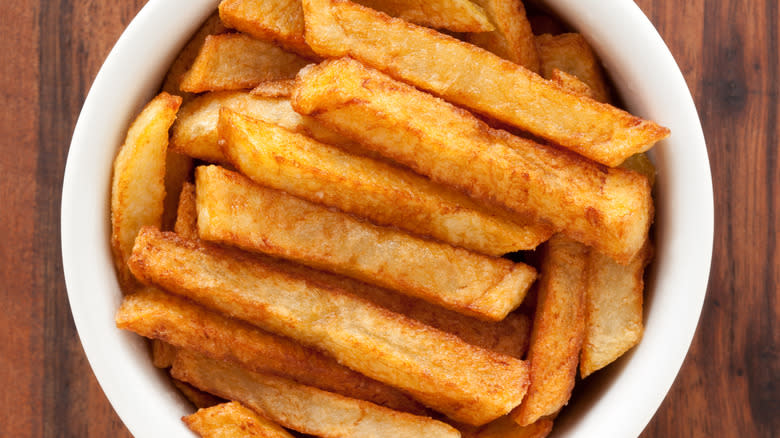
Whether eating out or at home, french fries are in demand. According to Tastewise, nearly 53% of all U.S. restaurants serve french fries, and in 2021 alone, nearly 160 million hundredweight of potatoes — a whopping 8 million tons — were used in the U.S. solely for making frozen french fries (via Statista).
If you want to enjoy french fries without hitting up the nearest burger joint or buying a bag of frozen fries, making them at home can be a great alternative. Homemade fries are fun, inexpensive — a five-pound bag of Russet potatoes at Hannaford supermarket costs about $4 — and can be customized with different spices and seasonings.
One thing you might need for homemade french fries is some cooking oil. Though it's not technically required, cooking oil helps produce the Maillard reaction, which browns the exterior of the fries while adding a distinct aroma and flavor. The high temperatures and direct oil contact also caramelize the sugars in the potatoes.
There are many types of cooking oils, and choosing the right oil can have a big effect on french fries, from how they taste to their health impact. We've dug into the many options to find the best cooking oils for making homemade fries so you can savor your next batch even more.
Read more: What These Imitation Foods Are Actually Made Of
Soybean Oil
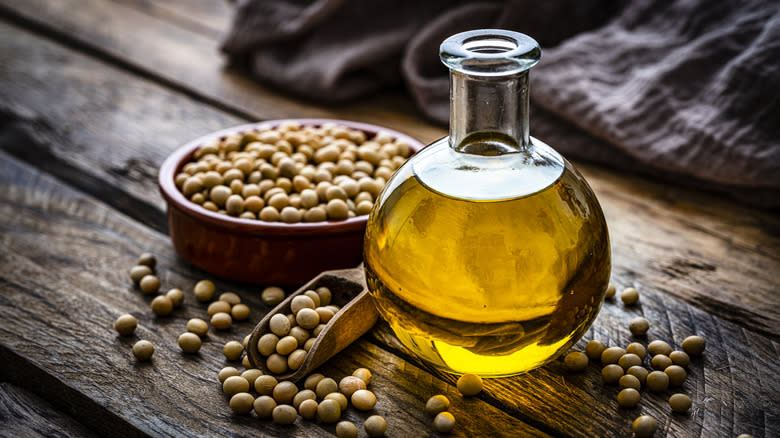
Want an all-purpose oil to make french fries and other goodies at home? Soybean oil is a strong choice. Falling under the larger category of vegetable oils, this oil comes from soybean plant seeds and is one of the world's most popular cooking oils — In 2022-23, 60.32 million metric tons of soybean oil were consumed worldwide, trailing only palm oil (via Statista).
There are plenty of reasons to like soybean oil as a homemade french fry oil. Soybean oil has a smoke point — the temperature when the oil begins smoking, breaking down, and potentially developing harmful carcinogens — of 450 F. In other words, it's more than enough for the temps needed to make fries nice and crispy. The oil is also high in polyunsaturated fatty acids, a heart-healthy type of fat, and contains plenty of omega-3 fatty acids and vitamin K as well.
Finally, soybean oil is affordable. A 2023 analysis published by Purdue University found soybean oil had the lowest price of all common cooking oils, averaging just 5.5 cents per ounce. So if you're on a budget or like making fries a lot, soybean oil won't hurt your bank account badly. The only major downside is that the Food and Drug Administration (FDA) has classified soybeans as one of nine major food allergens, with symptoms ranging from vomiting to dizziness. So make sure to use a highly refined version or skip it altogether if someone is allergic to soy.
Canola Oil

The third-most common cooking oil behind palm and soybean, canola oil is another solid option for making french fries. It's made from crushed canola plant seeds, which is a selectively bred or genetically modified variation of rapeseed. Because of this, "canola oil" and "rapeseed oil" are often used interchangeably, though technically, canola oil has less erucic acid and is also lower in glucosinolates.
By any name, canola oil has several attractive properties for French fry lovers. It has a lot of monounsaturated fats, which make it more stable at high temperatures, and has the least saturated fat of any major cooking oil. An article in Nutrition Reviews found canola oil was better than other fat sources in terms of total cholesterol levels and insulin sensitivity in its users. The relatively smaller amount of erucic acid — an omega-9 fatty acid that research has shown could be dangerous in large quantities — is a big benefit for canola oil versus rapeseed oil.
In addition, canola oil is another budget-friendly oil, coming in at 6.2 cents per ounce in the Purdue University review. Another point worth mentioning is canola oil's longevity. When stored properly, it lasts about a year, meaning you can stock up for frequent french fry making.
Palm Oil

Now let's talk about the aforementioned #1 most popular oil. More than 76 million metric tons of palm oil were devoured in 2022-23, and the reason is that it's a very useful oil — including for making french fries.
The biggest benefit of palm oil is that the same batch can be used repeatedly for frying. A study in the Asia Pacific Journal of Clinical Nutrition found that even after continuously using palm oil to cook French fries and chicken for five days, the oil was still acceptable for use, and the food itself was still satisfactory to a testing panel. This is excellent for people who have a home deep fryer and don't want to constantly change the oil.
Palm oil, which is derived from specific types of palm trees, also has excellent levels of tocotrienols. These reduce oxidative stress and lower one's risk for cancer. Like other neutral oils coming from fruits and seeds, it has a mild flavor and taste which lets your seasonings shine. The main reason palm oil doesn't rank higher is that it is high in saturated fat, which could potentially cause heart and inflammation issues in large amounts. In moderation, though, palm oil is a fine solution.
Peanut Oil
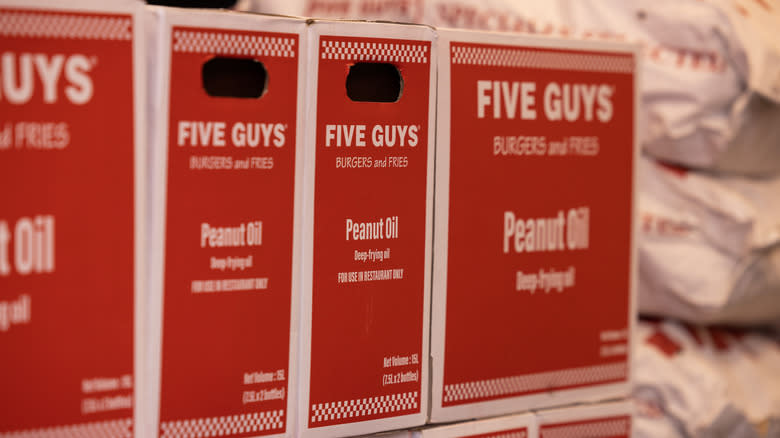
At least two popular U.S. quick service restaurants, Five Guys and Chick-fil-A, use peanut oil for their french fries. You can use it at home, too! Peanut oil is a good source of both monounsaturated and polyunsaturated healthy fats, and it's low in saturated fat. The oil also contains antioxidants and vitamin E to improve heart health.
The main reason people use peanut oil, though, is for taste, as it adds a nutty flavor. Peanut oil also doesn't take on the flavor of other foods, meaning you can cook french fries and chicken fingers (or something else) in peanut oil at the same time without them tasting like each other. The high smoke point of 450 F lets you get the outside crunchy while maintaining a soft inner texture.
But wait, you ask — what about peanut allergies? It's true that peanut allergies are dangerous stuff and can even be life-threatening. What you may not know, though, is the FDA does not classify highly refined peanut oil as a major food allergen. Why? Because the proteins that cause the allergic reaction are removed during the refining process. While a peanut oil allergy is still possible, it is much less common than a peanut allergy, and the symptoms are far milder.
Sunflower Oil

Sunflower oil has long been used as a medicine, and it's a good French fry cooking oil, too. As a non-volatile oil that comes from sunflower seeds, refined sunflower oil has a smoke point as high as 475 F, letting you get those fries crispy in a deep fryer or pan. Some of the medicinal benefits of sunflower oil will be present in your french fries, too, including high levels of vitamin E.
You also have some choices when it comes to sunflower oil. Depending on the variety, it can contain high levels of polyunsaturated fats (oleic acid), monounsaturated fats (linoleic acid), or both. The high linoleic acid version is more common, in part because of its improved stability at high heat. However, you can seek out a version high in oleic acid, which the FDA has found can lower heart disease risk.
The one concern is that sunflower oil has been found to release more aldehydes, some of which could be carcinogenic, compared to other cooking oils (via Journal of Hazardous Materials). Overall, though, sunflower oil has a lot going for your fried potatoes. In fact, some of the world's most famous French fries are cooked in this oil — McDonald's currently uses a blend of sunflower and rapeseed oils for all its frying.
Corn Oil
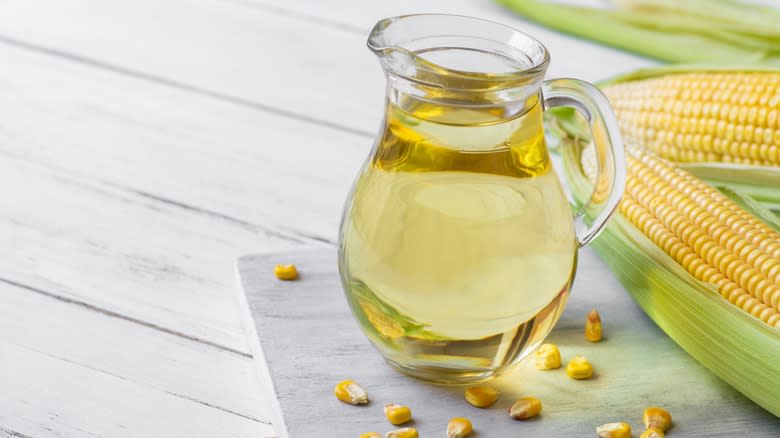
While many people are aware of corn syrup, corn oil is far less known — it's not even in the top nine of the most widely used vegetable oils. Nonetheless, corn oil is worth a look when making French fries. A byproduct of making cornmeal or cornstarch, corn oil is a good source of heart-friendly linoleic acid and vitamin E as well as anti-inflammatory phytosterols. In particular, the phytosterol levels are even higher than many other cooking oils already discussed, including olive and peanut oil — which helps cancel out the inflammatory properties of the polyunsaturated fatty acids.
You should also check out corn oil if you're on a budget. Though not quite as cheap as soybean and canola oil, corn oil is still plenty affordable, averaging 7.6 cents per ounce from 2018-22. Furthermore, the price didn't rise as much as these other oils in the same period, a possible indicator that the gap could narrow further. The smoke point is comparable as well so crispiness is never a concern. It won't be as beneficial as eating pure corn, since some nutrients are lost during the oil extraction process, but corn oil is one of the better french fry cooking oils.
Olive Oil
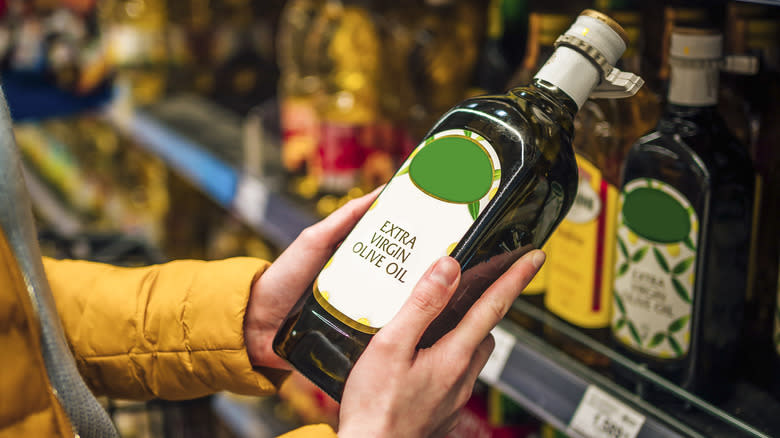
Although homemade french fries may never be categorized as a health food, olive oil gets them much closer. Long a staple of the Mediterranean diet, olive oil is loaded with healthy fats and a lot more. As noted by the International Journal of Molecular Science, the plant polyphenols in olive oil have many beneficial effects, including fighting inflammation, oxidation, and allergies.
Moreover, olive oil is more stable at high heat than other commonly used cooking oils (via Acta Scientific Nutritional Health). This stability means that fewer byproducts, such as free radicals and polar compounds are released during deep-frying and more of the healthy qualities are retained. And with well over 100 olive cultivars grown worldwide for olive oil production, you can experiment to impart the right taste to your fries.
This being said, we need to quickly mention two reasons why olive oil may be better suited for occasional french fry use. First, olive oil is expensive — on average, it costs five times more than soybean oil. Second, the smoke point can be as low as 350 F depending on the oil variety, meaning you might not be able to get your fries as crisp. Even so, olive oil for homemade French fries is worth considering.
Avocado Oil
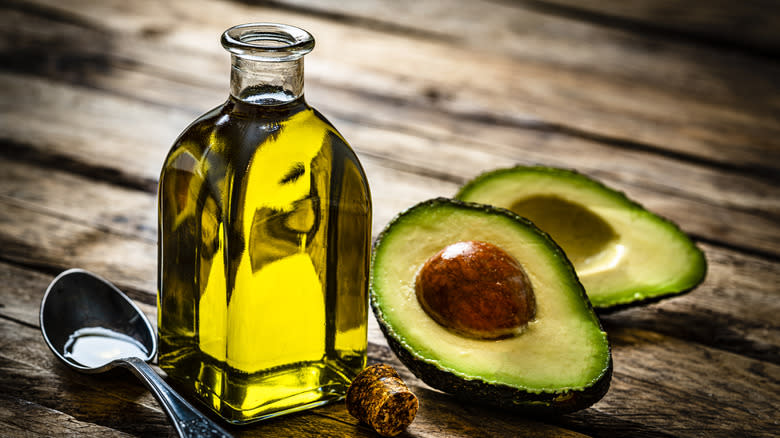
Do you like your fries with a nice crust and a meal texture? Then avocado oil is for you. The refined version has a mind-boggling smoke point of 520 F, letting you cook fries fast and crisp without worrying about the oil breaking down.
Avocado oil is also one of the healthier cooking oils you'll find. It's high in oleic acid, a monounsaturated fat that has been found to lower cholesterol, blood sugar, and inflammation (via Journal of Functional Foods). Avocado oil also contains antioxidants, improves nutrient absorption, and can even help with arthritis symptoms. Bet you never thought you could relieve joint pain by making some french fries! Unrefined avocado oil contains more of these nutrients than refined oil and has a stronger flavor profile if you want to give fries a unique taste, though its smoke point is slightly lower.
Despite costing even more than olive oil, avocado oil is a strong option for health-conscious french fry fans. Tread cautiously when shopping, though. A UC Davis study discovered more than 80% of "pure" avocado oil on the shelves is really blended oil or has already gone bad, so you must be prudent.
Rice Bran Oil
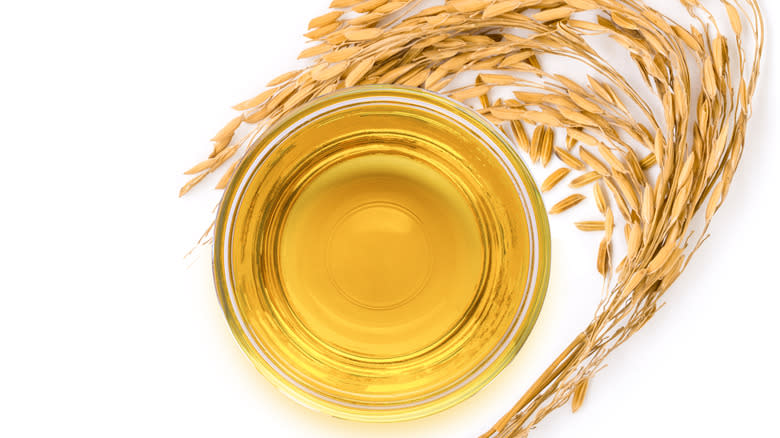
Never heard of rice bran oil? If it's available in your area, this cooking oil should be on your french fry shortlist. Coming from the outer bran of unprocessed rice — i.e. what's removed to turn brown rice into white rice — rice bran oil has become increasingly popular for cooking, especially around the San Francisco Bay (via SFGate). Professional chefs have noted rice bran oil gives food a lighter texture and helps it stay crisp. Additionally, the oil remains stable through repeated heat cycles, and it has more of a mild nutty smell and taste, making it similar to peanut oil in that regard.
That's before we get to the possible health benefits. The oil is laden with both poly- and monounsaturated fats, which are better for your cardiovascular system than saturated fats. It provides vitamins E and K, and can reduce the risk of type 2 diabetes (or help manage it in people who already have this condition). The one major concern is that rice oil extraction is often done using chemicals. They are removed during refining, but the environmental impact of this process may be a factor for some people.
Safflower Oil

As long as no one eating your fries has a ragweed allergy — and/or the oil is well-refined — frying in safflower oil is another nice option for people who prefer extra-crispy potatoes. In fact, among major cooking oils, only refined avocado oil has a higher smoke point than the 510 F that safflower oil clocks in at. The flavor is milder than most oils, so it won't interfere with your secret herb and spice blend.
Research has also espoused many health advantages of safflower oil. It includes a lot of unsaturated fat and has fewer saturated fats than the well-regarded olive and avocado oils we've discussed. And while safflower oil isn't exactly cheap, Consumer Reports found it to cost less per ounce than either of these oils. The oil also could reduce blood pressure and even the chances of blood clots.
Also noteworthy is a study published in Clinical Nutrition linking regular safflower oil consumption to lower blood sugar, inflammation, and cholesterol in people with type 2 diabetes. Since potatoes are known to spike blood sugar levels, safflower oil can therefore counter this effect, making it a good frying oil if you have diabetes but still want french fries.
Cottonseed Oil

Cotton plants aren't just for making shirts and pants. The vegetable oil extracted from the seeds is also good for cooking. Per the National Cottonseed Products Association, cottonseed oil predates many of the other cooking oils found on store shelves (via FarmProgress). Though it was usurped in popularity by other oils like soybean and canola, cottonseed oil has been making a comeback.
Notably, food manufacturers consider cottonseed oil the "gold standard" when making snack foods. Science backs them up — a study from The University of Tennessee found that not only did potato chips fried in cottonseed oil taste better than those fried in soybean or palm oils, but the chips also lasted longer in storage. It stands to reason they'll do the same for your french fries.
Cottonseed oil also has no trans fats, and its smoke point of 420 F is sufficient for most at-home chefs. In 2023, the USDA announced a new cotton plant had been developed with a better balance of oleic and linoleic fatty acids, meaning even more potential cardiovascular health perks. Ultimately, availability could be the biggest deterrent to using cottonseed oil. Our local Hannaford doesn't even carry it, so you may have to order online and/or buy in bulk.
Blended Vegetable Oil

Can't decide what type of oil you want to make french fries in? A blended oil could be the right move. In its most basic terms, vegetable oil is any oil coming from "seeds, nuts, cereal grains, and fruits" (via ScienceDirect). However, the cooking oil industry often uses the term "vegetable oil" to refer to a mix of oils from multiple plant sources, with the exact blend depending on the manufacturer.
The biggest upside to using blended oil is its versatility. If you want one oil that can be used for French fries, sauteing, baking, and other cooking, blended vegetable oil is the right choice. It's also a way to get the benefits of multiple types of oils. For example, by combining canola and palm oils, you get an oil that lasts longer than straight canola oil while having less saturated fat than pure palm oil.
When you're shopping for vegetable oil, you'll need to check the label to see the blend and thus know its properties. Soybean is the most common oil for blending, but the concoction may include any of the oils mentioned above. Incidentally, this is the approach Wendy's takes, cooking their fries in a soybean oil-based blend that can also contain canola, corn, and/or cottonseed oils.
Ghee

Traditionally used in India and the Middle East, ghee is also good for making homemade French fries. If you're not familiar with ghee, it's a type of clarified butter that's made by evaporating cow butter. The result is a liquid fat with similar cooking properties to refined oils.
Though you can make clarified butter by boiling butter at home, true ghee is produced at temperatures below 100 F. This method preserves more nutrients, including vitamins A, D, E, and K, which assist with everything from heart health to reducing the risk of cataracts. Ghee also contains high levels of butyrate and conjugated linoleic acid (CLA). The former is a fatty acid proven to lower inflammation and promote digestive health while the latter may help with insulin resistance and weight control.
Last but not least, ghee has a nutty flavor and sweet smell, giving your fries a little more zest. Since most or all the lactose is removed when making ghee, it's usually okay for someone with dairy sensitivity. Just be sure to enjoy ghee in moderation because of the higher saturated fat levels.
Beef Tallow
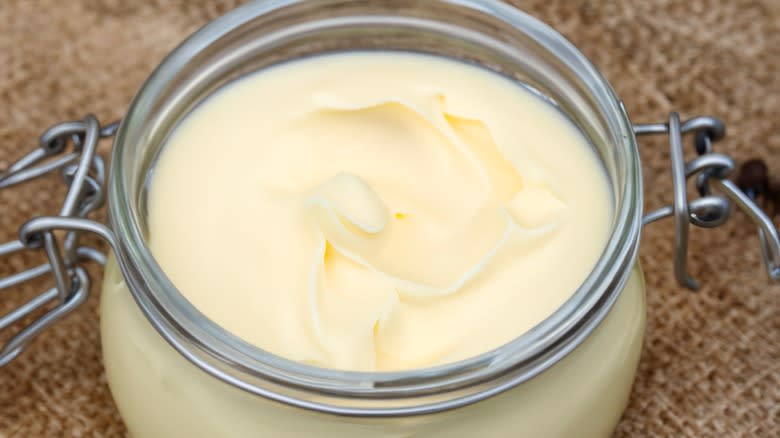
Technically, beef tallow isn't an oil. It's rendered beef fat with a texture resembling that of butter. When it's heated up, though, beef tallow becomes liquid gold for many French fry enthusiasts — at least those who aren't vegetarian or vegan. The subtle meat flavor it adds to the fries can make a big difference.
As for nutrition, while it is higher in saturated fat than some oils, beef tallow has good amounts of monounsaturated fat, and some experts think the saturated fat may not be as bad for you as previously thought (via Nutrition Journal). It also provides many of the nutrients we've mentioned, including conjugated linoleic acid and vitamins D and E. And you can make it at home!
For further evidence of beef tallow's effectiveness, look no further than McDonald's. Until 1990, they used 93% beef tallow to make their World Famous Fries?. When they switched to 100% vegetable oil in 1990 in response to the continued lobbying of the National Heart Savers Association, it noticeably affected the taste and texture of the fries — and right after the announcement, the company's stock price fell over 8% (via Chicago Tribune). Although they didn't go back to tallow, McDonald's now uses "natural beef flavor" in its fries to try and replicate the taste.
Read the original article on Daily Meal.